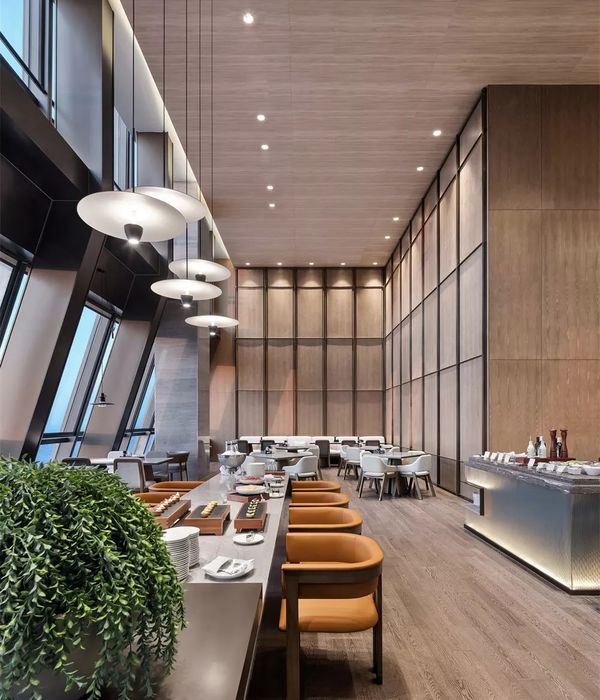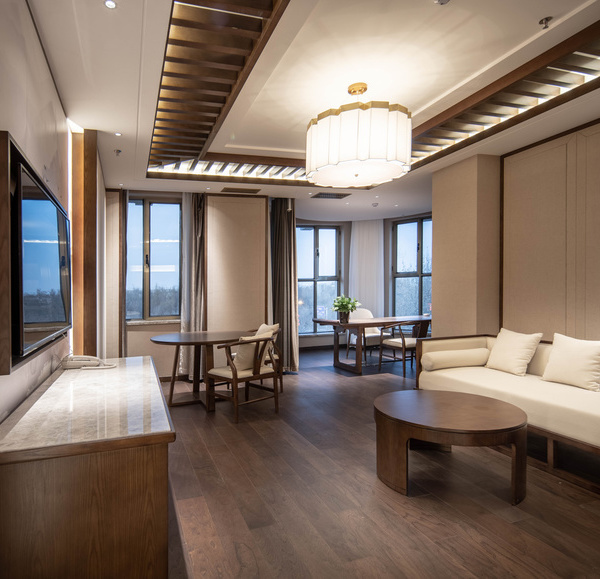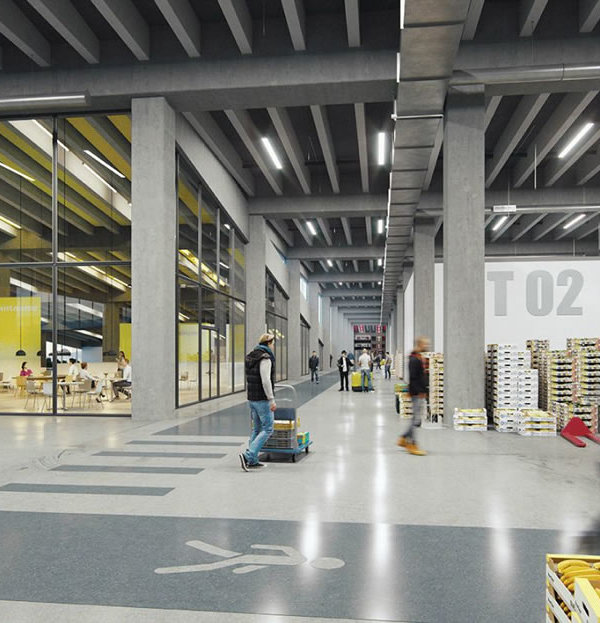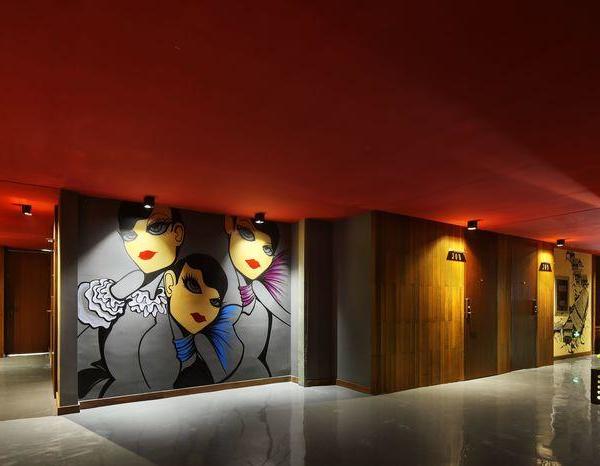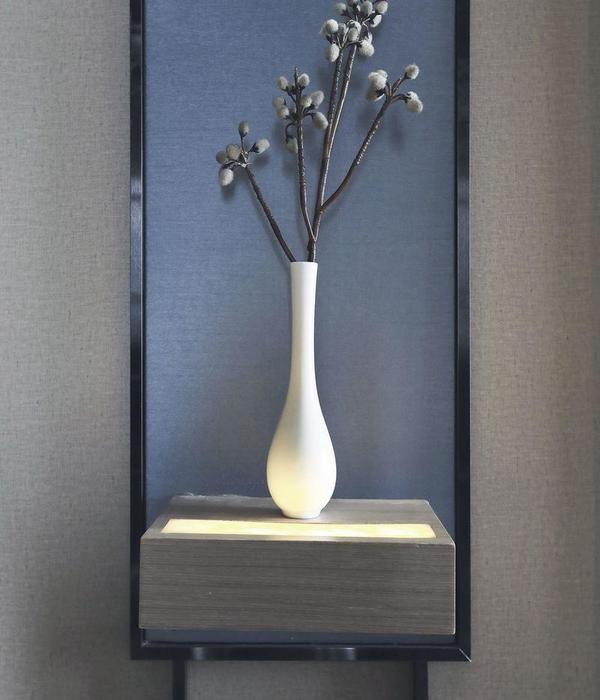从Mt William到Eddystone Point的徒步旅程中,Fires湾北部边界是必经之路。在四天的徒步行程中,这座位于边界处的木屋可为经停者提供两晚过夜服务。该木屋的基本设施可满足两位步行导游和十位徒步者的需求。该驿站是Aboriginal Land Council经营下的首个该类型驿站。
The site fringes the northern edge of the Bay of Fires, and serves as a two night stop over for a 4 day guided walk through the cultural landscape, from wukalina – Mt William, to larapuna – Eddystone Point. The brief required accommodation and communal facilities for 2 guides and 10 walkers. It is the first walk of its kind in Tasmania that is entirely owned and operated by the Aboriginal Land Council.
▼隐蔽在茂密林中,hidden in the landscape
走近建筑之前,来访者需穿越一片沿海沙区,跨越一片茂密的沿海植被,与各种陆地生物不期而遇。krakani lumi隐藏在一片banksia marginata(一种植物)之中,唯有近在迟尺才能显现。由塔斯马尼亚焦木打造的小木屋,散布在场地中,黝黑的外貌如同阳光透过banksia洒下的斑驳树影。各自独立的驿站建筑看上去坚固又密实,似乎可以抵抗一切腐蚀性海洋气候。居住小屋内的床上铺着夹有棉花的袋鼠皮毯子,被原住民称之为reore;还有maleleuca ericifolia(一种当地的花草)散发出来的淡淡香气,曾被用以提醒原住民们在夜间保持警觉。这所有的细节都是对原住民的生活追忆。
The approach to the site is made from an exposed and pristine beach dune, through open coastal heath that is rich in diverse flora and animal-life. Impossible to see until arriving, krakani lumi is enveloped deep within a grove of banksia marginata. Clad in charred Tasmanian timber, the individual structures appear as a series of discrete dark pavilions, merging as shadows into the surrounding dense banksia, camouflaging the camp when it is not in use. The exterior of the individual structures of the standing camp are robust, tautly detailed and resilient to the corrosive sea air and to tampering. Within the sleeping huts, the bedding is supplemented with quilted wallaby furs – known traditionally as ‘reore’, and the space is scented with the essential oil of the local maleleuca ericifolia: a flower that was traditionally used to aid sleep.”
▼散布在场地中的黑色居住小屋,the huts are distributed on the site
▼居住小屋,the living hub
隐藏在滑动门之后的半球形结构空间,营造了温暖又舒适的半户外氛围。场地环境以及由Tasmania第一批迁居传承下来的建造形式,给予该半球形空间极大的设计灵感。在当地原始居住建筑内,这一拱形结构常由树枝和树皮搭建,而半球形空间则常用木炭笔绘出圆形点缀,用以映射夜晚的星空。传统的开放性半球形空间,可以让来访者拥有更加开阔的室内居住体验。徒步至此的旅行者,在建筑的诉说中体会这个国家的文化和精神。而这一充满故事性的空间,也成为了krakani lumi最重要的组成部分之一。深色的焦木包裹着柔和的内部,内外转换之间,也描绘了原住民们的生活状态,是对这个国家文化和历史的诉说与尊敬。
When the individual structures are opened, a warm half-domed blackwood-lined interior is exposed. The proportion and materiality of these vaulted interiors is derived from the siting, form and qualities of the traditional seasonal shelters of Tasmania’s first peoples. Predominantly made of arched branches and sheets of bark, the interior of the traditional half-dome structures were often covered in charcoal drawings of circular motifs, and depictions of the constellations. The open spatiality of the traditional half dome form amplifies the experience of dwelling within a larger landscape room. The telling of the creation is a speaking into being of country. It is an initiation into the cultural and spiritual interior of the landscape. This context and the notion of the story-telling interior is an important parti for krakani lumi. Through the revelation of the interior, a story of concealing and revealing is told, which belongs to the privileged cultural experience. The exterior charred ‘skin’, which conceals and protects the narrative of the interior forms, ensures agency to the Aboriginal community in the telling of their story.
▼驿站周身由焦木打造,the architecture is cladded in charred Tasmanian timber
▼隐藏在滑动门之后的半球形结构空间,a warm half-domed blackwood-lined interior is hidden behind a sliding door
▼由半球形空间进入公共起居室,from a warm half-domed space to the living space
▼暖色调公共起居室内部环境,a warm interior of the communal building
▼洗手间,toilet
▼夜色,night view
▼总平面图,master plan
▼公共起居室平面,communal building plan
▼公共起居室立面,communal building elevation
▼公共起居室剖面,communal building section
▼居住木屋平面,hut plan
▼居住木屋立面,hut elevation
▼居住木屋剖面,hut section
{{item.text_origin}}


